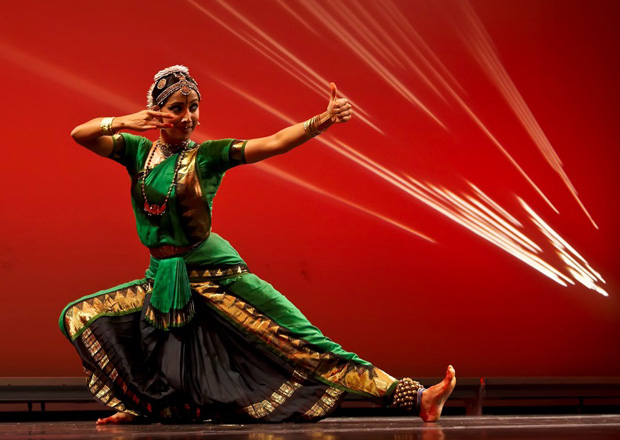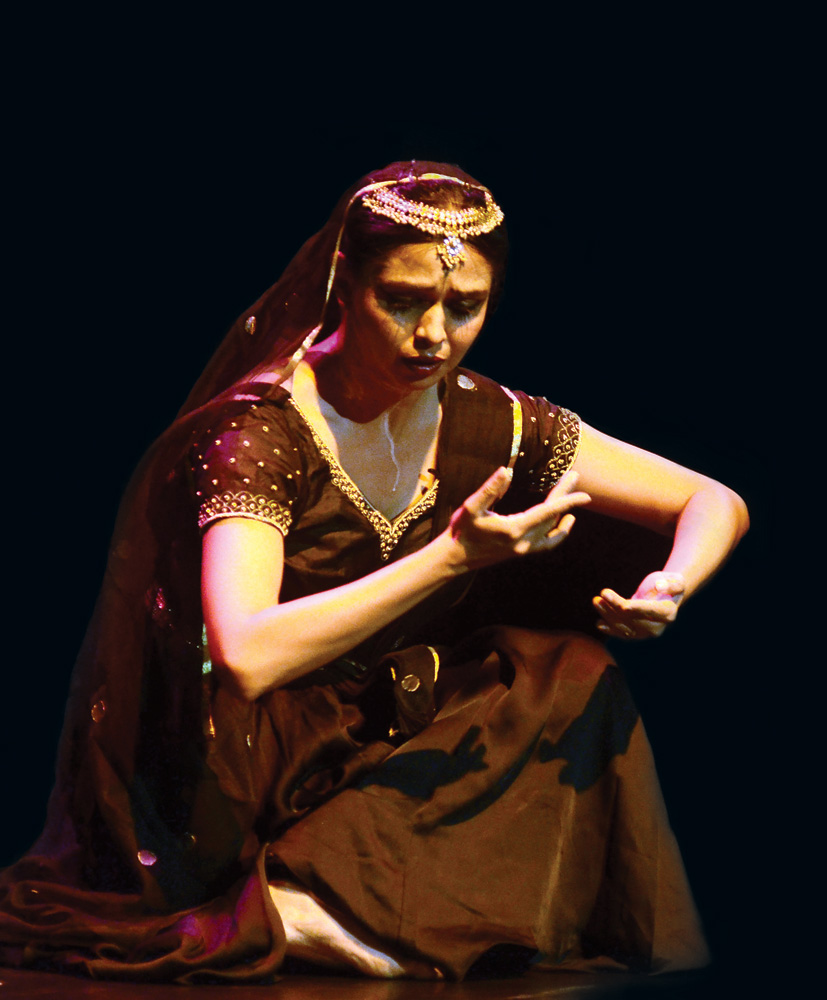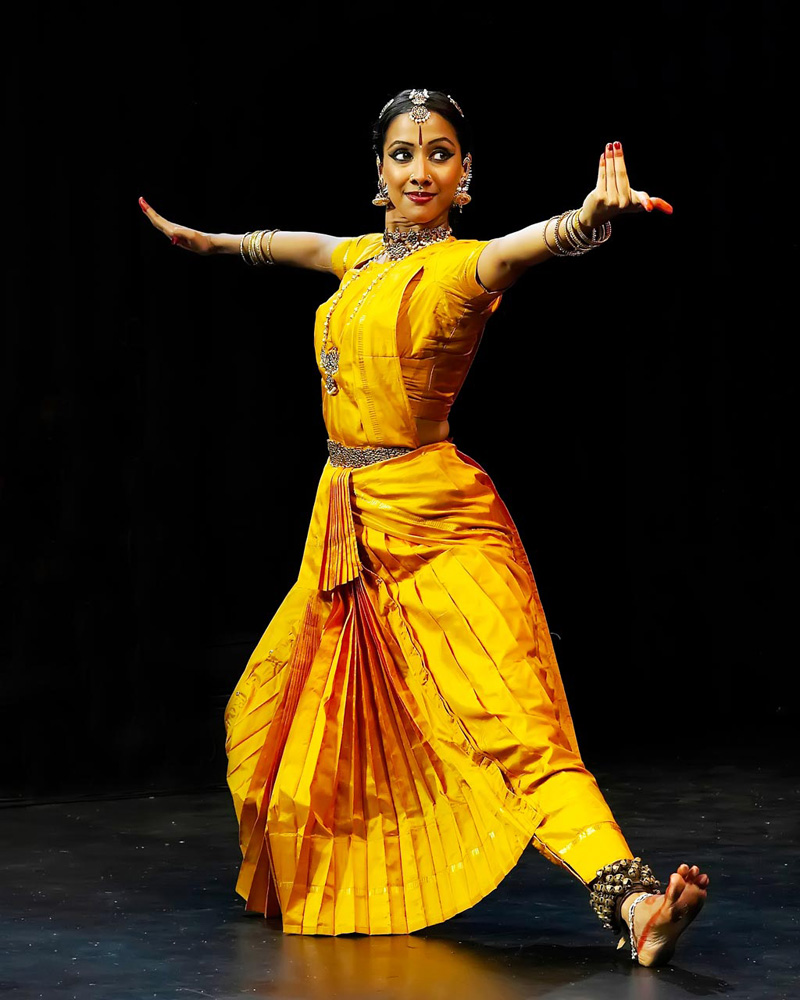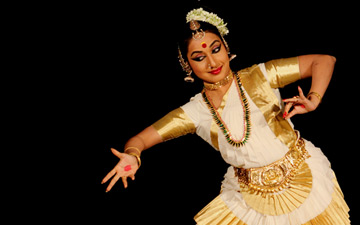
© Jorge Viscera. (Click image for larger version)
World Music Institute, Dancing the Gods season
Mythili Prakash: Jwala-Rising Flame (23 April)
Sanjukta Wagh: Rage and Beyond: Irawati’s Gandhari (24 April)
★★★✰✰
New York, Symphony Space
23, 24 April 2016
www.mythiliprakash.com
www.worldmusicinstitute.org
www.symphonyspace.org
Goddesses, on their Own Terms
The Dancing the Gods festival, presented by the World Music Institute and co-curated by the dancer and scholar Rajika Puri, is a reliable place to see good, and sometimes great Indian classical dance. The curators are careful to bring a variety of styles, balancing innovation and classicism. This year’s festival consisted of two nights, one of bharatanatyam, probably the most commonly-performed variety of Indian dance, and the other inspired by kathak, a from Northern India. The dancers were Mythili Prakash and Sanjukta Wagh, respectively. Both were accompanied by live music. Prakash’s traditional Carnatic musical ensemble (violin, fnger cymbals, mridangam drum, and voice) was extraordinary.
Every classical and folk form is pulled between tradition and innovation. We’ve seen it in flamenco for years: flamenco fused with tap or modern dance, or turned into avant-garde dance theatre (à la Israel Galván). Success or failure usually rests on whether the disparate elements cancel each other out or magically fuse to create something that is captivating on its own terms. Both Prakash and Wagh included certain non-traditional elements, though Wagh’s Rage and Beyond: Irawati’s Gandhari went much farther afield. Her one-woman show, accompanied by the guitarist Hitesh Dhutia, was less an evening of kathak than a story-telling evening leavened with dance and song.

© Narendra Dangiya. (Click image for larger version)
The subject of Rage and Beyond is Ghandari, a character from the Mahabarata. As the story goes, princess Ghandari was married off to a blind prince, Dhritarashtra, after which she took to wearing a blindfold as an act of marital solidarity. Her 100 sons were killed in a devastating war between two branches of the same family. Here, her story is reinterpreted as a feminist morality tale, her self-blinding as a metaphor for women’s lack of autonomy in traditional society. (The interpretation is based on the writings of the anthropologist Irawati Karve, excerpts of which are projected onto the stage.) The death of Ghandari’s children becomes a symbol of the tragic spoils of war. No wonder she feels rage. “Every telling of history is filtered,” Prakash intones, adding that in India, “certain social structures, like the patriarchal household, live on.”
Relevant as her take on the story may be, the format and delivery – first-person narration interspersed with song, commentary, and dance – was simply too didactic to result in a satisfactory evening of theatre. Nor was Wagh’s elegant, precise dancing well served by the simple, atmospheric guitar accompaniment. There was no rhythmic complexity for her to work against, no foil for the patter of her feet. Her singing was more effective, but the whole felt like less than a sum of its parts.
The opposite was true in Prakash’s Jwala – Rising Flame. In fact, here, it was almost impossible to distinguish the dancer from her extraordinary musical environment. Her footwork vied with the dizzying complexity (and swing) of Anjna Swaminathan’s rhythms. Her upper body responded to the rich harmonies produced by the voices of Roopa Mahadevan and Aditya Prakash. I’ve never heard vocal harmony used in Carnatic music, and was struck by its seductive effect. Swaminathan, a rare female classical Indian percussionist, is quite simply a virtuoso, remarkable for the speed and variety of her playing. There are few things more thrilling than watching a bharatanatyam dancer jam with a band of this level.

© Jorge Viscera. (Click image for larger version)
The innovations here were subtle, both musical and choreographic. Like many bharatanatyam evenings, this one had a theme: the flame as a symbol of life, inspiration, and the universe. One of the songs was atypical, a setting of a Sufi poem by Aditya Prakash, the choreogarpher’s brother. (He also sang.) The slow, incantatory melody had a faintly Arab, or even Moorish lilt. In response, Prakash’s dancing became meltingly fluid, with a creamy legato; she seemed to swim through the air, her eyes closed. (The song was called “Becoming,” and developed the idea of losing oneself in infinity.)
Throughout, her connection to the music was intense. At times, her fingers became a visualization of the rhythm, rising and falling. In “Jwala” she embodied the qualities of a flame, using her hands to evoke its ever-changing nature. The flickering of her fingers and wrists, the only part of her that moved, was mesmerizing. (Such isolation of a single body part is atypical.) Later, her whole body became the flame, filling the stage with her spins. She’s a compelling actress, as well. In “Energy,” she became a mother playing with her infant, kissing and caressing him and asking for kisses in return, putting him to bed, covering him with a blanket. The audience hung on her every gesture and change of expression.
The poems on which the dances were based were recited in voiceover before each entrance. It’s a clumsy format, but a necessary one. In bharatanatyam, as in many Indian dance forms, words, music, and movement are one and the same. The combination is intoxicating.

















You must be logged in to post a comment.